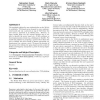185 search results - page 35 / 37 » A Lattice-Based Public-Key Cryptosystem |
CCS
2008
ACM
13 years 8 months ago
2008
ACM
The standard solution for user authentication on the Web is to establish a TLS-based secure channel in server authenticated mode and run a protocol on top of TLS where the user en...
CCS
2008
ACM
13 years 8 months ago
2008
ACM
The Unified Model (UM) key agreement protocol is an efficient Diffie-Hellman scheme that has been included in many cryptographic standards, most recently in the NIST SP 80056A sta...
CORR
2010
Springer
13 years 5 months ago
2010
Springer
Quantum Cryptography or Quantum key distribution (QKD) is a technique that allows the secure distribution of a bit string, used as key in cryptographic protocols. When it was note...
WISEC
2009
ACM
14 years 23 days ago
2009
ACM
In wireless sensor networks, it is critical to restrict the network access only to eligible sensor nodes, while messages from outsiders will not be forwarded in the networks. In t...
WPES
2006
ACM
13 years 12 months ago
2006
ACM
Oblivious submission to anonymity systems is a process by which a message may be submitted in such a way that neither the anonymity network nor a global passive adversary may dete...

